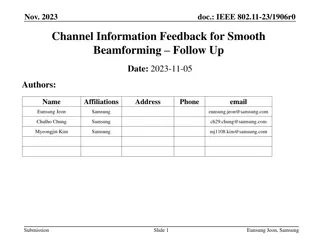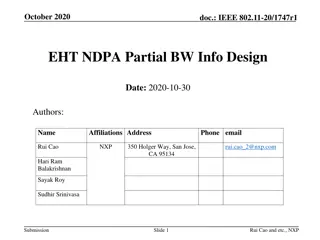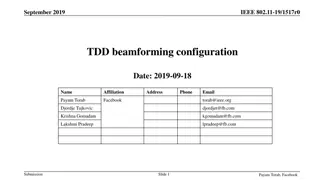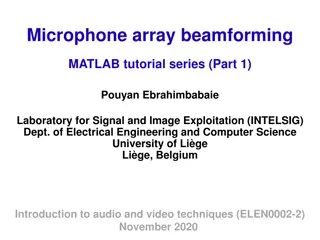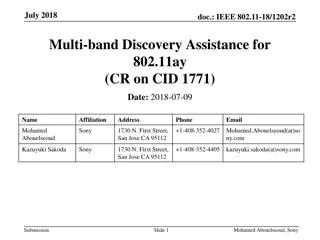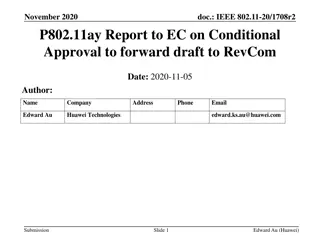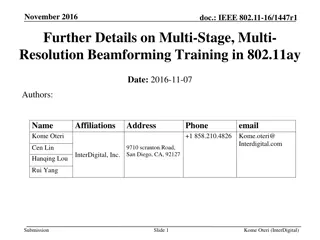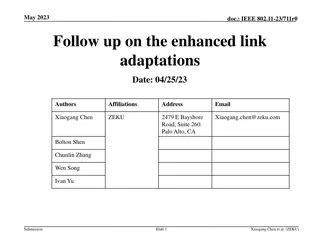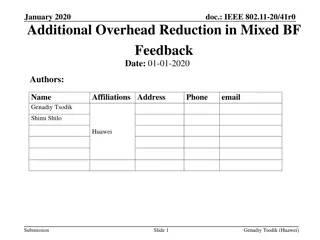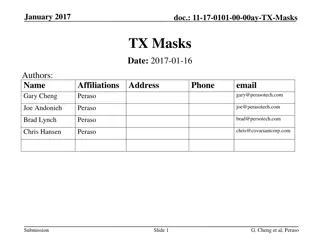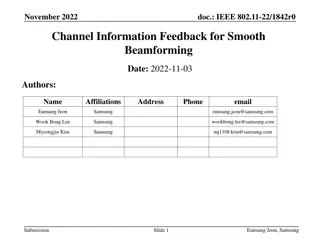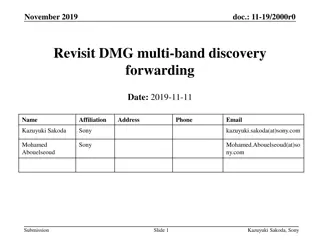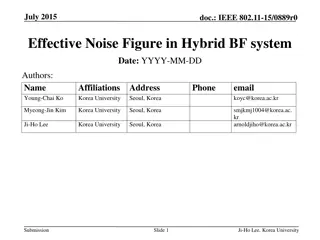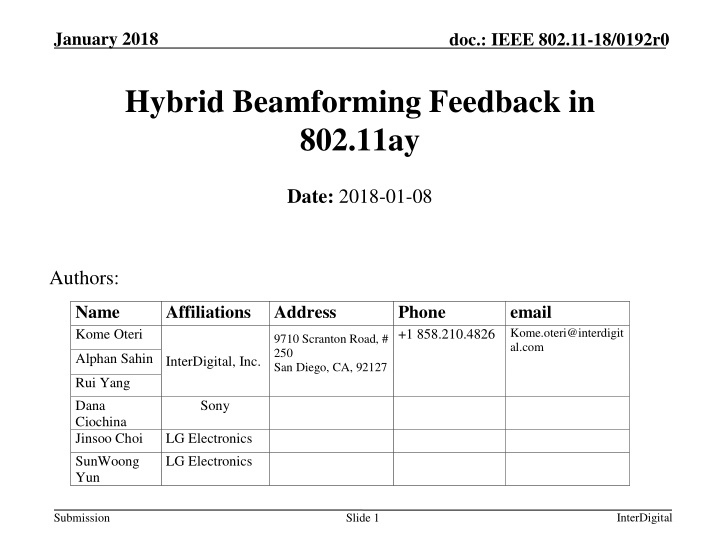
Hybrid Beamforming Feedback in IEEE 802.11ay - Detailed Protocol
Explore the detailed protocol for Hybrid Beamforming Feedback (HBF) in IEEE 802.11ay, discussing phases like Announcement, Sounding, and Feedback. Understand the information required for HBF transmission and the differences between SC and OFDM PPDUs. Learn about OFDM Request Parameters and how they are specified for VHT NDPA in 802.11ay.
Download Presentation

Please find below an Image/Link to download the presentation.
The content on the website is provided AS IS for your information and personal use only. It may not be sold, licensed, or shared on other websites without obtaining consent from the author. If you encounter any issues during the download, it is possible that the publisher has removed the file from their server.
You are allowed to download the files provided on this website for personal or commercial use, subject to the condition that they are used lawfully. All files are the property of their respective owners.
The content on the website is provided AS IS for your information and personal use only. It may not be sold, licensed, or shared on other websites without obtaining consent from the author.
E N D
Presentation Transcript
January 2018 doc.: IEEE 802.11-18/0192r0 Hybrid Beamforming Feedback in 802.11ay Date: 2018-01-08 Authors: Name Kome Oteri Affiliations Address Phone +1 858.210.4826 email Kome.oteri@interdigit al.com 9710 Scranton Road, # 250 San Diego, CA, 92127 Alphan Sahin InterDigital, Inc. Rui Yang Dana Ciochina Jinsoo Choi SunWoong Yun Sony LG Electronics LG Electronics InterDigital Submission Slide 1
January 2018 doc.: IEEE 802.11-18/0192r0 Introduction TGay has agreed that 11ay will support hybrid precoding for SU-MIMO and MU-MIMO [1] Performance of hybrid precoding with the transmission and reception of EDMG Single Carrier Mode PPDUs has been shown in [2], and [3] and on EDMG OFDM PPDUs in [4]. The results show gains of hybrid precoding over analog precoding in certain scenarios e.g. antenna configuration, transmit power. To enable HBF in 802.11ay, a framework for the HBF protocol was agreed to in [7]. In this contribution, we present the details needed for HBF feedback including: OFDM Request Parameters OFDM Response Parameters Feedback Information and Feedback Frame Format InterDigital Submission Slide 2
January 2018 doc.: IEEE 802.11-18/0192r0 HBF Protocol Details The Hybrid Beamforming Protocol comprises the following phases Announcement Phase Sounding Phase Feedback Phase On completion of the HBF protocol, HBF transmission can take place HBF protocol Initiator Announcement (Exp,I) HBF Transmission (I) Sounding (Exp,I) Exp: Explicit I: Initiator Announcement ACK (Exp,I) Feedback (Exp,I) Responder Explicit HBF Protocol for Initiator Only InterDigital Submission Slide 3
January 2018 doc.: IEEE 802.11-18/0192r0 Feedback Phase Feeds back HBF information needed by transmitter for HBF transmission. The Hybrid Beamforming information differs for SC vs OFDM PPDUs SC PPDU : Time domain information: precoder and/or channel OFDM PPDU : Frequency domain precoder information D1.0 supports Time domain feedback HBF in the SC PPDU mode Support for feedback for the OFDM PPDU is needed. This will need a mechanism for: OFDM Request Parameters OFDM Response Parameters Feedback Information and Feedback Frame Format InterDigital Submission Slide 4
January 2018 doc.: IEEE 802.11-18/0192r0 OFDM Request Parameters VHT NDPA and subfields [6] For 802.11ay, create signaling identical to 802.11ac Feedback Type to indicate feedback details Nc Index sent only if Feedback Type is set to MU a STA may decode at most 2 spatial streams so Nc index = 2 Parameters requested in the EDMG BRP Request element (9.4.2.255) InterDigital Submission Slide 5
January 2018 doc.: IEEE 802.11-18/0192r0 EDMG BRP Request element [8] B0 B7 Element ID B8 B15 Length B16 B23 Element ID Extension B24 B31 L-RX B32 B39 L-TX-RX B40 B50 TX Sector ID B51 B52 EDMG TRN-Unit P 2 B53 B56 EDMG TRN-Unit M 4 B57 B58 EDMG TRN-Unit N 2 Bits: 8 8 8 8 8 11 B59 TXSS- REQ B60 B61 B63 TXSS-PACKETS B64 B66 TXSS- REPEAT B67 TXSS-MIMO TXSS-INITIATOR s: 1 1 3 3 1 B68 B73 BRP CDOWN 6 B74 B81 B82 B84 B85 B86 B87 B89 B90 TX Mask 8 Antenna Comeback Delay 3 First Path Training 1 Digital Request 1 BF Feedback Type 1 Nc Index Reserved 1 6 Modify Reserved field to 6 bits to make number of bits divisible by 8 Table xx Value 0 1 Meaning Nc = 1 Nc = 2 InterDigital Submission Slide 6
January 2018 doc.: IEEE 802.11-18/0192r0 EDMG BRP Request element New Field Descriptions [8] The Feedback Type field indicates the type of feedback requested. Set to 0 for SU and set to 1 for MU. If the Feedback Type field indicates MU, then the Nc Index field indicates the number of columns, Nc, in the compressed beamforming feedback matrix minus 1 for HBF feedback in the EDMG OFDM PPDU mode. The interpretation of this field is defined according to Table xx. InterDigital Submission Slide 7
January 2018 doc.: IEEE 802.11-18/0192r0 OFDM Response Parameters VHT MIMO Control field and subfields [6] Create new element to indicate the parameters of the feedback InterDigital Submission Slide 8
January 2018 doc.: IEEE 802.11-18/0192r0 Open Issues Tone Grouping - Grouping Ng and Number of subcarrier fields: Static Grouping size and values of Ng in 802.11ac : Ng = 1, 2 and 4 Need to define other values (mandatory and optional) Coefficient Size: Quantization of angles: Quantization based on SU/MU parameter in 802.11ac: (b / b ) set to SU : 2 /4 and 4/6, MU: 5/7 and 7/9 Need to define the corresponding values in 802.11ay InterDigital Submission Slide 9
January 2018 doc.: IEEE 802.11-18/0192r0 Simulation Assumptions Based on 11ay OFDM PHY [1] Channel bandwidth 2.64 GHz (512 DFT size) Spatial and frequency mapping is given in the appendix Modulation and coding is the same for all streams MMSE receiver Conference room (CR) scenario in 11ay/ad channel model [5] Subscenario: STA-AP Detailed assumptions can be found in the appendix 3.0 m window STA 8 STA 3 STA 7 4.5 m STA 4 STA 1 STA 5 STA 2 STA 6 y AP (in ceiling) 0 door x 0 InterDigital Submission Slide 4
January 2018 doc.: IEEE 802.11-18/0192r0 Baseband Beamforming Methods No Beamforming: Baseband precoder is set to identity, i.e. only analog beams used and Nss columns of identity matrix as Beamforming matrix cross all antennas No channel knowledge needed at transmitter Closed loop with Ideal Feedback: Use SVD-based Beamforming in the frequency domain for each subcarrier, i.e., per-tone BB Beamforming (no water filling) Full Channel State Information (CSI) knowledge at transmitter Feedback every sub-channel : Ng = 1 Feedback wideband channel : Ng = NFFT/2 No quantization InterDigital Submission Slide 11
January 2018 Simulated SU-MIMO Configurations doc.: IEEE 802.11-18/0192r0 Beamforming implemented in all configurations Analog beamforming: Using phase shifter at each antenna to align Tx and Rx beams Digital beamforming: Spatial streams are precoded (as described in slide Baseband Beamforming Methods ) and distributed to all antennas Simulation Configuration #4 of the SU-MIMO configurations [5] #4: 4x4 channel, 2 PAAs with dual polarization on each side InterDigital Submission Slide 12
January 2018 doc.: IEEE 802.11-18/0192r0 Unbalanced: Conf #4, 2 Layers ~0 dB ~0.2 dB ~0.2 dB For an unbalanced setup, i.e., 4x4 MIMO and 2 layers: BB Beamforming improves the PER performance by 1.5-2 dB. Difference between wideband and sub-band feedback is less than 0.2 dB Suggests Ng > 4 may be used. InterDigital Submission Slide 13
January 2018 doc.: IEEE 802.11-18/0192r0 Feedback Information and Frame Format Information to be fed back Average SNR for each STS (in Channel Measurement Feedback Element) Beamforming Feedback Matrix indexed on sub-carrier (OFDM) or time domain tap (SC) Optional for MU: Differential SNR per stream for each 2Ng band (OFDM) MU Exclusive Beamforming Report Field Create BF Feedback element in to capture this information InterDigital Submission Slide 14
January 2018 doc.: IEEE 802.11-18/0192r0 Conclusion In this contribution, we have discussed the details of the feedback for the feedback phase of the HBF protocol. We have discussed the following: OFDM Request Parameters OFDM Response Parameters Feedback Information and Feedback Frame Format We have defined parameters and signaling for the OFDM Request Parameters. InterDigital Submission Slide 15
January 2018 doc.: IEEE 802.11-18/0192r0 References 1. 2. IEEE P802.11ay /D1.0 L. Sun, et al, Link Level Performance Comparisons of Open Loop, Closed Loop and Antenna Selection for SU-MIMO 11-16/0911r1 K. Oteri et al, Closed Loop SU-MIMO Performance with Quantized Feedback 11- 16/1446r0 . K. Oteri, et, al, Hybrid Beamforming for SC and OFDM Transmission in 11ay 11- 17/1533r1 A. Maltsev, et al, Channel models for IEEE 802 11ay , IEEE doc. 11-15/1150r4 IEEE 802.11-2016 K. Oteri, et. al, Draft Text for Hybrid Beamforming Protocol Design Details , 11- 17/1692r1 K. Oteri, et. al., Draft Text for OFDM Feedback Request , 11-18/0193r0 3. 4. 5. 6. 7. 8. InterDigital Submission Slide 16
January 2018 doc.: IEEE 802.11-18/0192r0 Straw Poll 1 Do you agree to the following? 802.11ay shall signal the Feedback Type and Nc Index fields for HBF feedback with the OFDM PPDU in the EDMG BRP Request Element as in 11-18/0193r0 Draft Text for OFDM Feedback Request . Y/N/A InterDigital Submission Slide 17
January 2018 doc.: IEEE 802.11-18/0192r0 APPENDIX InterDigital Submission Slide 18
January 2018 doc.: IEEE 802.11-18/0192r0 Channel parameters [5] Channel bandwidth 2.64 GHz, center frequency 60.48 GHz Channel model: Scenario: CR, Sub-scenario: STA-AP. STA is placed at a plane 2m below AP in the cubicle 1. Random rotation around z-axis between STA/AP. For SU-MIMO configuration #2, TX/RX analog beamforming for both polarizations are based on the LOS direction Each PAA has 2x8 elements 2x2 channel, 1 PAA with dual polarization, on each side, support up to 2 layers theoretically For SU-MIMO configuration #4, TX/RX analog beamforming for both polarizations of PAA#i are based on the LOS direction between TX PAA#i RX PAA#i Each PAA has 2x8 elements 2x2 channel, 1 PAA with dual polarization, on each side, support up to 4 layers theoretically Distance between center of PAAs 10cm InterDigital Submission Slide 19
January 2018 doc.: IEEE 802.11-18/0192r0 Mapping Coded bits 1 Coded bits 2 Coded bits L Coded symbols 1 Coded symbols 2 Coded symbols L Streams Layers I F F T I F F T I F F T p/s I F F T p/s p/s p/s p/s p/s p/s Antenna ports Baseband precoding OFDM Symbols InterDigital Submission Slide 20
January 2018 doc.: IEEE 802.11-18/0192r0 Channel Frequency Response InterDigital Submission Slide 21

